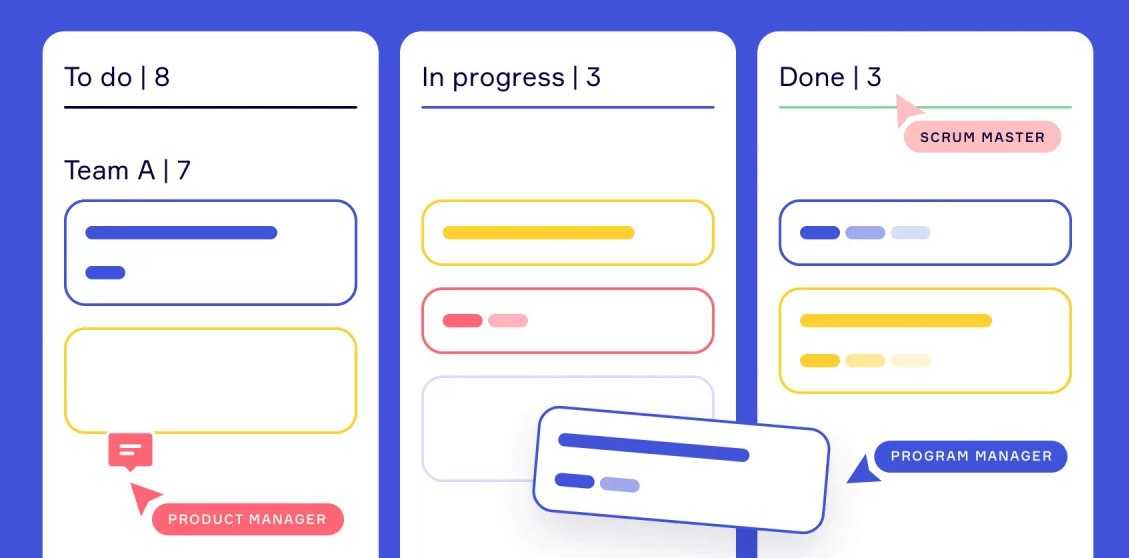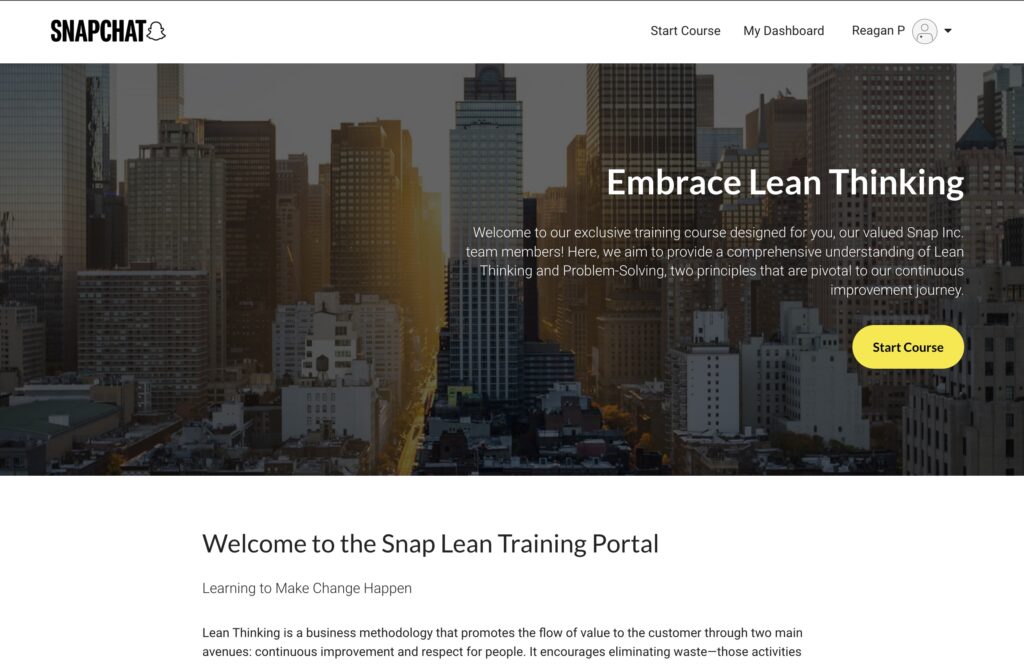What is Kanban? – The Kanban System
The Japanese word “kanban” means “visual board” or a “sign”, and it has been used as a process definition since the early 1960s. Kanban is a workflow management method that’s used to define, manage, and improve a variety of services. It aims to help the user better visualise their work and goals, whilst maximising efficiency, and improving continuously.
Kanban System Explained
Originating from the world of manufacturing, it later became a territory that was claimed by Agile software development teams for their own complex systems. Recently, it has attracted much attention from businesses and industries across the globe, as many brands choose to use the kanban method for the sake of their operations.
It was not a regular sit-down meeting where everyone turns up a few minutes late with freshly brewed mugs of coffee and a moleskin notepad. You were more likely to see people turn up with scribbles on a sheet of paper. Neither was it scheduled in the diary.
So what does kanban mean?
Kanban is a Japanese word that means “signboard” or “billboard.” It is also a name for the popular manufacturing and project management system known as the Kanban Method. The Kanban Method is based on the principle of visualization. By making the progress of work visible to everyone involved in a project, it becomes easier

To begin with, kanban came about as a scheduling system for lean manufacturing processes, originating from within the depths of the Toyota Production System (TPS). As the late 1940s drew to a close, the employees at Toyota introduced a new method of “just in time” manufacturing to its production line.
This approach represented a pull system, meaning that production is based solely on customer demand rather than the standard push practice that encourages you to produce goods first, and then push them out onto the market. The goal is to manage workflow and reduce the cycle times for items to be completed.
Their unique JIT production system laid the foundations of what is now known as Lean manufacturing. The core purpose of kanban is to minimise waste without having to sacrifice productivity, creating better value for the customer without actually generating more costs internally.
At the beginning of the 21st century, boffins inside the technological and software industries quickly realised how kanban could positively impact upon the way that their products and services were delivered. So, by harnessing advances in computing technology to better improve efficiency, kanban successfully left the automotive industry to be applied to other complex commercial sectors including but not limited to IT, software development, R&D, and many more.
So, what is now recognised as the official kanban method is what emerged at the beginning of 2007. Anyone can build their own kanban system, as you need nothing more than to set up a straightforward Kanban board with three basic columns, “requested”, “in progress” and “done”. When the kanban method is properly constructed and managed and is functioning correctly, it will serve as a real-time data repository that highlights any bottlenecks within the system, as well as anything else that would interrupt your goals of smooth, uninterrupted working practices.
History of Kanban
The Kanban methodology, also known as the Kanban process, has a rich history dating back to the 1940s when it was developed by the Toyota Motor Corporation. The history of Kanban can be traced back to the Japanese word for signboard, which was used to implement Kanban in the manufacturing process. Kanban was developed to improve production efficiency, reduce waste, and enhance communication between teams.
Over time, the Kanban methodology has evolved into a powerful tool for managing and optimizing workflows across a wide range of sectors and industries, enabling businesses to achieve greater agility, flexibility, and productivity. Today, organizations around the world continue to implement Kanban to improve their operational processes and drive business success.
“First, how could I protect my team from the incessant demands of the business and achieve what the Agile community now refers to as a “sustainable pace”?
David J. Anderson, Kanban Tweet
How Is Kanban Implemented?
When you are aiming to implement the kanban method, every organisation must be careful to follow only the most practical steps. There are six core practices that need to be present for a successful implementation, and while mastering these is vital, it’s still an evolving process that can change and adapt to suit the climate as years fly by. Here are the six core practices:
Step 1.) Visualise the Workflow
To visualise your process with a kanban system, you will need to source a board with a few cards and columns. Each column on the board should represent a step in your workflow, whilst each card represents a work item. The kanban board itself represents the state of your workflow with all of its various risks and specifications.
The first and most valuable thing to understand is what it takes to get an idea from a simple request to a fly deliverable product. Recognising how workflows through your system will point you in the direction of continuous improvement by helping you to make informed and necessary changes. Whenever you start working on an item, you pull it from the “to do” column, and when it is completed, you can then transfer it across to the “done” section. This way, you can easily track progress and spot issues or drawbacks that can affect your production line or any other commercial

Step 2.) Limit Work in Progress (WIP)
One of kanban’s primary functions is to ensure that only a manageable number of active items are in progress at any one time. If there are no work-in-progress limits, you simply are not participating in kanban operations. Making the mistake of switching a team’s focus halfway through a task will generally cause more harm than good, and multitasking is a sure route to generating waste and inefficiency. Limiting WIP means implementing a pull system on parts of the workflow, meaning you can set a maximum number of items per stage to ensure that a card is only “pulled” into the next step when there is available capacity.
Step 3.) Manage Flow
Managing your flow refers to the movement of work items through the production process, as you must ensure they move at a predictable and sustainable pace. One of the main goals when implementing a kanban system is to create a smooth and healthy flow of production, so instead of trying to micro-manage people by keeping them busy all of the time, you should focus on better understanding the practices and how to get that work faster through the system. This would mean that your kanban system is helping you to create value in a much faster timeframe.
Step 4.) Make Process Policies Explicit
You can’t improve something you don’t understand, so that’s why your process should be clearly defined, published, and socialised. People would not associate and participate in something they do not believe would be useful, but when everyone is familiar with the common goal, they would be able to work together and make informed decisions to encourage the most positive impact. Sparse, visible, well-defined, and subject to change (if/when needed), work policies have the power to boost people’s self-organisation, benefiting your brand in a number of different ways.
Step 5.) Feedback Loops
For teams and companies that want to be more agile, implementing feedback loops is a mandatory step. They ensure that organisations are adequately responding to any changes, and enable a transfer of knowledge between stakeholders, too. Kanban suggests the use of feedback loops at a team level as well as service-oriented cadences. Service-oriented cadences in kanban such as operations, service delivery, and risk meetings aim to synchronise and improve the delivery of your services. The output of these reviews, such as understanding what is blocking the most effective service delivery can serve as a decision influencing factor for the continuous improvement of your network of services. While focused and regular meetings with fewer attendees have proven to be a good practice, the ideal duration of specific kanban cadences depends on your context, the size of your team, and the topics that you cover.
Step 6.) Improve Collaboratively (using models & the scientific method)
The way to achieve continuous improvement and sustainable change inside any organisation is through collaboratively implementing changes based on nothing but scientifically proven methods, feedback, and metrics. Establishing an organisational culture in which every hypothesis is tested to prove whether they have positive or negative results is absolutely crucial for developing a business mindset that is focused on constant improvement through evolutionary change, so there’s no time like the present to implement such a step.
So, Why Should You Adopt The Kanban Method?
Increased Visibility of the Flow
The basic idea of Kanban is visualising every piece of work. This way, the Kanban board turns into a central informational hub, and everyone is on the same page. All tasks are visible and they never get lost, which brings transparency to the whole work process. Every team member can have a quick update on the status of every project or task.
Improved Delivery Speed
Kanban offers multiple ways for project managers to closely monitor and make informed analyses of the distribution of work. With a clear view over the work items completed for a certain period of time, the stages where tasks spend the longest, bottlenecks are easy to identify. Teams are enabled to tackle these challenges to improve their workflow and, ultimately, their delivery rate.
Alignment between Business Goals and Execution
Promoting transparency, encouraging feedback, and regular review meetings, kanban practices enable aligning the company’s strategic goals with teams’ day-to-day work. This alignment between the business direction and execution enhances the agility of an organisation. It allows teams to adapt to changing priorities and reorganisations due to change in the market or customer’s preferences.
Improved Predictability
Once you create your own kanban board and begin accumulating work items on it, you’ll be able to understand your process in depth with flow metrics. Analysing the amount of time that tasks spend in your workflow (cycle time) will enable you to improve your predictions on how much work you can deliver in the future. Understanding your delivery rate consistency will make your forecasts more accurate, and you can base your decisions on historical data.
Improved Ability to Manage Scale and Dependencies
The intrinsic kanban practice to visualisation can also be applied when it comes to mapping and managing dependencies. Managing dependencies provides both insights on the present state of a workflow and ideas for future improvement opportunities. It also enables full transparency for strategic management over the workflow and the existing links between teams.
Reduced Waste Output
The origin of the kanban method implies that work should only be done when there is a demand. In other words, kanban navigates you to reduce waste by working solely on tasks that are needed at present, rather than creating a large stock of goods that may not get bought or used.
What are the kanban service delivery principles
The Kanban Method is founded on the following four principles:
1.Start with what you do now: The Kanban Method begins with an evaluation of the current state of your work processes. This helps to ensure that any changes made are based on a solid understanding of how things are currently being done.
2.Agree to pursue incremental, evolutionary change: Once the current state of your work processes has been assessed, you can then begin making gradual improvements. This incremental approach helps to minimize disruption and maximize the chances of success.
3.Respect the current process, roles, and responsibilities: As you work to improve your processes, it is important to respect the existing roles and responsibilities of those involved. Making major changes to roles and responsibilities can create confusion and chaos, which can undermine the entire effort.
4.Encourage acts of leadership at all levels: Everyone involved in a project has the potential to be a leader. By encouraging leadership at all levels, you can tap into the collective knowledge and experience of the team to make the Kanban Method even more effective.

When was kanban invented?
The Kanban Method was invented by Taiichi Ohno, an industrial engineer at Toyota, in the 1950s. Ohno developed Kanban as a way to improve the efficiency of Toyota’s manufacturing operations. The Kanban Method has since been adopted by companies and organizations around the world as a way to improve the efficiency of their work processes.
Digital Kanban Boards
The Kanban Method can be implemented using physical kanban boards, which are specially designed whiteboards that have columns and rows for tracking the progress of work. Alternatively, the Kanban Method can be implemented using digital kanban boards, which are software applications that provide a visual representation of work in progress. Digital kanban boards have the advantage of being accessible to team members who are working remotely, which can be a major benefit for distributed teams.
100% Free Fundamentals of Lean COURSE
Big brands like Pixar, Spotify and Zara all use the kanban method.
Pixar was heavily inspired by the initial kanban system that was implemented by the Toyota Production Team. However, in Pixar’s case the process involved far more creativity. For Edwin Catmull, the President of Pixar Animation Studios, it was crucial that each film was made in the right order. Which meant that after a process was completed, it was passed on to the next team, who would in turn transfer it down the chain.
A kanban board was used to achieve this, and it also helped to provide a lot of visibility to all teams involved so that they could see exactly what everyone else was doing at any point of the process. It also made them aware of how their work affected the other team members. This helped Catmull instil lean manufacturing techniques in his organisation and create a culture where anyone could ‘pull the cord’ and ‘stop the line’.
How have companies embraced Kanaban?
Embracing kanban was one of the best decisions ever made in Spotify, which is now the biggest subscription streaming music platform ever. Spotify turned to kanban after struggling hard to find time to execute the projects they had planned. Spotify’s method was based on the simple adoption of a kanban board with 3 vertical columns – to do, doing and done. Spotify categorised its work into three separate areas – small, medium, or large. Small tasks would take a day, medium sized ones a few days, and large jobs a week. Larger assignments were broken into small, medium, and large tasks and seamlessly inserted into their kanban board.
Zara is one of the biggest fashion retailers in the world, and it has tried and tested kanban systems for many years. To stay ahead in the fashion race, Zara updated its fashion collections continuously by always holding a low level of stock. Kanban systems are operated right from the store level, so sales managers are responsible for their own kanbans. Orders are sent to the head office twice weekly, and are based on the current sales data. In addition, the most saleable items that are in high demand are always part of the list. The commercial team will process the order, keeping in mind the most popular clothing trends, and the order is shipped to the store within just a couple of days.
The kanban method works excellently for all kinds of lean businesses that wish to cut their costs and total waste without negatively impacting on the quality of their products or their standard of customer service, so there’s no time like the present to get involved.








